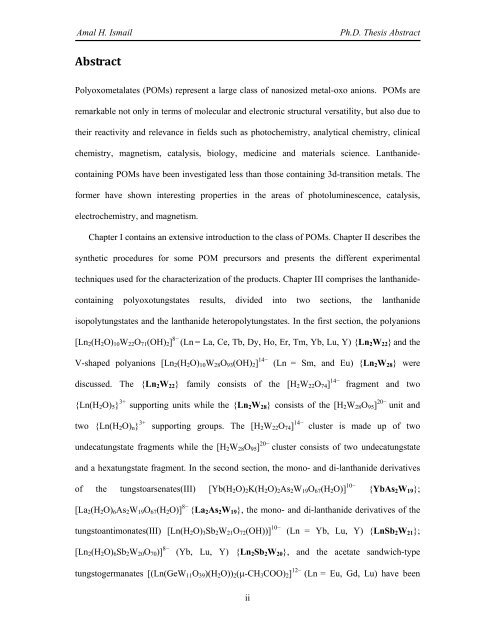Synthesis and Structural Characterization of ... - Jacobs University
Synthesis and Structural Characterization of ... - Jacobs University
Synthesis and Structural Characterization of ... - Jacobs University
Create successful ePaper yourself
Turn your PDF publications into a flip-book with our unique Google optimized e-Paper software.
Amal H. Ismail<br />
Ph.D. Thesis Abstract<br />
Abstract<br />
Polyoxometalates (POMs) represent a large class <strong>of</strong> nanosized metal-oxo anions. POMs are<br />
remarkable not only in terms <strong>of</strong> molecular <strong>and</strong> electronic structural versatility, but also due to<br />
their reactivity <strong>and</strong> relevance in fields such as photochemistry, analytical chemistry, clinical<br />
chemistry, magnetism, catalysis, biology, medicine <strong>and</strong> materials science. Lanthanidecontaining<br />
POMs have been investigated less than those containing 3d-transition metals. The<br />
former have shown interesting properties in the areas <strong>of</strong> photoluminescence, catalysis,<br />
electrochemistry, <strong>and</strong> magnetism.<br />
Chapter I contains an extensive introduction to the class <strong>of</strong> POMs. Chapter II describes the<br />
synthetic procedures for some POM precursors <strong>and</strong> presents the different experimental<br />
techniques used for the characterization <strong>of</strong> the products. Chapter III comprises the lanthanidecontaining<br />
polyoxotungstates results, divided into two sections, the lanthanide<br />
isopolytungstates <strong>and</strong> the lanthanide heteropolytungstates. In the first section, the polyanions<br />
[Ln 2 (H 2 O) 10 W 22 O 71 (OH) 2 ] 8− (Ln = La, Ce, Tb, Dy, Ho, Er, Tm, Yb, Lu, Y) {Ln 2 W 22 } <strong>and</strong> the<br />
V-shaped polyanions [Ln 2 (H 2 O) 10 W 28 O 93 (OH) 2 ] 14−<br />
(Ln = Sm, <strong>and</strong> Eu) {Ln 2 W 28 } were<br />
discussed. The {Ln 2 W 22 } family consists <strong>of</strong> the [H 2 W 22 O 74 ] 14− fragment <strong>and</strong> two<br />
{Ln(H 2 O) 5 } 3+ supporting units while the {Ln 2 W 28 } consists <strong>of</strong> the [H 2 W 28 O 95 ] 20− unit <strong>and</strong><br />
two {Ln(H 2 O) n } 3+<br />
supporting groups. The [H 2 W 22 O 74 ] 14− cluster is made up <strong>of</strong> two<br />
undecatungstate fragments while the [H 2 W 28 O 95 ] 20− cluster consists <strong>of</strong> two undecatungstate<br />
<strong>and</strong> a hexatungstate fragment. In the second section, the mono- <strong>and</strong> di-lanthanide derivatives<br />
<strong>of</strong> the tungstoarsenates(III) [Yb(H 2 O) 2 K(H 2 O) 2 As 2 W 19 O 67 (H 2 O)] 10− {YbAs 2 W 19 };<br />
[La 2 (H 2 O) 6 As 2 W 19 O 67 (H 2 O)] 8− {La 2 As 2 W 19 }, the mono- <strong>and</strong> di-lanthanide derivatives <strong>of</strong> the<br />
tungstoantimonates(III) [Ln(H 2 O) 3 Sb 2 W 21 O 72 (OH))] 10− (Ln = Yb, Lu, Y) {LnSb 2 W 21 };<br />
[Ln 2 (H 2 O) 6 Sb 2 W 20 O 70 )] 8−<br />
(Yb, Lu, Y) {Ln 2 Sb 2 W 20 }, <strong>and</strong> the acetate s<strong>and</strong>wich-type<br />
tungstogermanates [(Ln(GeW 11 O 39 )(H 2 O)) 2 (-CH 3 COO) 2 ] 12− (Ln = Eu, Gd, Lu) have been<br />
ii

















